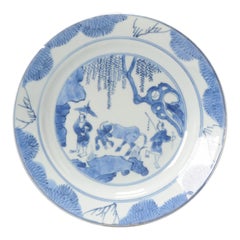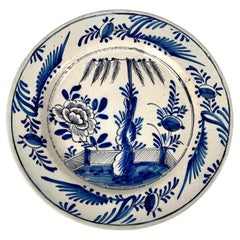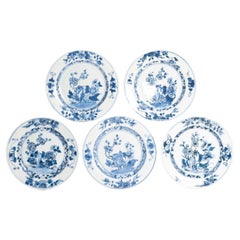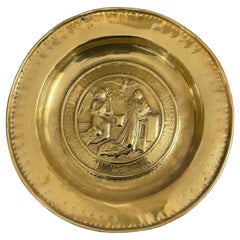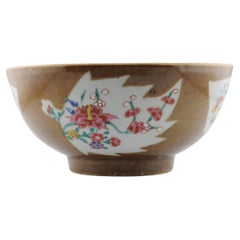18th Century and Earlier Bowls and Baskets
to
384
924
924
2,095
11,818
3,399
1,654
6,052
2,407
248
104
355
443
254
1,138
1,535
1,032
348
135
59
25
23
20
18
9
9
9
3
2
1
688
530
126
79
61
614
279
484
447
327
322
106
Height
to
Width
to
924
924
924
9
4
3
3
3
Period: 18th Century and Earlier
Rare Kangxi Period Chinese Porcelain Plate with Ox and Figure Landscape
Located in Amsterdam, Noord Holland
Fabulous quality blue and white porcelain plate in Ming style but Kangxi period, Interesting border decoration.
Marked with a sacred mushroom.
Additional information:
Material: Por...
Category
Chinese Antique 18th Century and Earlier Bowls and Baskets
Materials
Porcelain
$2,375 Sale Price
20% Off
Antique Blue and White Delft Charger Hand Painted Netheralands, circa 1780
Located in Katonah, NY
Hand painted circa 1780, this eye-catching blue and white Delft charger is hand painted in shades of cobalt blue with black accents. ...
Category
Dutch Rococo Antique 18th Century and Earlier Bowls and Baskets
Materials
Delft
Antique Ca 1720 Qing Dynasty Chinese Porcelain Porridge Dishes Blue White
Located in Amsterdam, Noord Holland
A very nicely decorated SET of 6 dishes in Blue and white, Kangxi/Yongzheng Period. Decorated with flowers.
Additional information:
Material: Porcelain & Pottery
Color: Blue & White...
Category
Chinese Antique 18th Century and Earlier Bowls and Baskets
Materials
Porcelain
$1,093 Sale Price / set
20% Off
A German Repousse Brass Alms Dish, 17th Century
Located in ARMADALE, VIC
A German Repousse Brass Alms Dish, 17th Century
Origin and Function:
These brass dishes were primarily made in Nuremberg, Germany, and were initially ...
Category
German Antique 18th Century and Earlier Bowls and Baskets
Materials
Brass
18th Century Rustic Primitive genuine Folk Art Wooden bowl original paint
Located in Boden, SE
An exceptional large rare oval shaped 18th century primitive Swedish carved wooden knot bowl. Shows a dry textured finish showing a stunning aged patina. A truly remarkable piece. Th...
Category
European Folk Art Antique 18th Century and Earlier Bowls and Baskets
Materials
Pine
Antique Kangxi/Yongzheng Chinese Porcelain Cafe au Lait Bowl, 18th Century
Located in Amsterdam, Noord Holland
Kangxi/Yongzheng period, cafe au lait and Famille Rose. Lovely piece!
Chinese café au lait porcelain is a type of Chinese porcelain that was made particulary in the 18th and 19th c...
Category
Chinese Qing Antique 18th Century and Earlier Bowls and Baskets
Materials
Porcelain
$720 Sale Price
20% Off
18th Century Baroque Style Baptismal Charger in Brass
Located in Haddonfield, NJ
An 18th century baptismal plate in brass with beveled flower decoration to celebrate the birth of the infant or perhaps as in French is called "Plat a offrandes", which means "Plate ...
Category
European Baroque Antique 18th Century and Earlier Bowls and Baskets
Materials
Copper, Gold Plate
Antique Chinese Porcelain Bowl With Landscape, Jiajing – Wanli Period 1560-1600
Located in Amsterdam, Noord Holland
Lovely decorated piece. A rare type with landscape
China Jingdezhen kilns
Ming Dynastie, Jiajing or Wanli Reign
Provenance:
– Private collection Netherlands
Additional information:
...
Category
Chinese Antique 18th Century and Earlier Bowls and Baskets
Materials
Porcelain
$3,611 Sale Price
20% Off
Antique Worcester Porcelain Bowl Imari Style Dr Wall First Period England C-1755
Located in Katonah, NY
This mid-18th century First Period Worcester Porcelain bowl was made in England circa 1755.
It is hand-painted in the beautiful Worcester Imari style ”Fan Pattern.”
The pattern is al...
Category
English Japonisme Antique 18th Century and Earlier Bowls and Baskets
Materials
Porcelain
Italian Bronze Mortar & Pestle
Located in Savannah, GA
An Italian bronze mortar and pestle, 18th century.
3 ¾ inches wide by 3 ⅜ inches deep by 2 inches tall
Category
Italian Antique 18th Century and Earlier Bowls and Baskets
Materials
Bronze
Antique Ming Period Chinese Porcelain Literatus & Attendant Charger Flies Whisk
Located in Amsterdam, Noord Holland
Sharing this new arrival. An amazing Blue and white porcelain dish, Kraak porcelain.
China, Ming dynasty Wanli period (1572-1620),
Decorated in the centre with a literatus and...
Category
Chinese Ming Antique 18th Century and Earlier Bowls and Baskets
Materials
Porcelain
$7,586 Sale Price
20% Off
Antique Chinese Porcelain Master of the Rocks Bowl, Early Kangxi Period, 1660-70
Located in Amsterdam, Noord Holland
Sharing this fantastic early Kangxi bowl 17th century.
Decorated to the exterior with fishermen in an extensive river landscape, the base marked ‘Guang Yu...
Category
Chinese Qing Antique 18th Century and Earlier Bowls and Baskets
Materials
Porcelain
Antique Blue & White Kraak Style Dutch Delftware Plate, 18th Cenury
Located in Amsterdam, Noord Holland
Earthenware dish with a flat rim. Decorated in different shades of blue on a white tin glaze
Additional information:
Material: Porcelain & Pottery
Region of Origin: Europe
Period: 1...
Category
European Antique 18th Century and Earlier Bowls and Baskets
Materials
Porcelain
$1,139 Sale Price
20% Off
Antique Cup from 18th Century in Qianglong Period, China
Located in Norton, MA
Antique cup from 18th century China. A supper and rear antique from the Qianglong period.
Measures: height is 2 1/2", 2 1/2" in diameter, and 3 1/4" wide ...
Category
Chinese Antique 18th Century and Earlier Bowls and Baskets
Materials
Porcelain
Set of Three Leedsware Lattice Baskets and Underplate
Located in New York, NY
Set of three Leedsware lattice baskets and underplate. Cobalt blue trimmed cream colored basketweave patterned pottery tray with reticulated border and ...
Category
English Antique 18th Century and Earlier Bowls and Baskets
Materials
Pottery
Antique Ko-Imari Edo Period Japanese Porcelain Dish Arita, 17th C
Located in Amsterdam, Noord Holland
A very nice blue and white dish of moulded shape. Unusual shape and painting and mark.
Early Edo period.
Dating to 1680-1700
Similar object in Shibata collectie Part II - nr 261
...
Category
Japanese Edo Antique 18th Century and Earlier Bowls and Baskets
Materials
Porcelain
$811 Sale Price
20% Off
Antique Edo Period Japanese Porcelain Plate Arita Kraak Dish, ca 1680-1700
Located in Amsterdam, Noord Holland
Sharing with you this very nice edo period, 1680-1700, example. With a central scene of a flowers. The rim beautifully painted, quite unusual.
Unmarked at base.
Arita ware, also k...
Category
Japanese Edo Antique 18th Century and Earlier Bowls and Baskets
Materials
Porcelain
Large Chinese Porcelain Blue and White Charger Plate, 1720-1740
Located in Amsterdam, Noord Holland
A very nicely decorated and potted Chinese Porcelain plate. Absolutely beautiful piece.
Additional information:
Material: Porcelain & Pottery
Region of Origin: China
Decoration Typ...
Category
Chinese Qing Antique 18th Century and Earlier Bowls and Baskets
Materials
Porcelain
Antique Ming Period Chinese Porcelain Dish Kosometsuke Fisherman
Located in Amsterdam, Noord Holland
Sharing with you this nice Chinese porcelain dish from the early 17th century. Once again Jingdezhen made but for the Japanese market, Kosometsuke. Visible is a landscape scene with ...
Category
Ming Antique 18th Century and Earlier Bowls and Baskets
Materials
Porcelain
$3,151 Sale Price
20% Off
Edo Period Japanese Porcelain Kakiemon Bowl Bamboo Flowers Prunus, 18th Century
Located in Amsterdam, Noord Holland
Lovely & High Quality Japanese Porcelain Kakiemon bowl.
The deep sides supported on a short tapering foot, the interior decorated with bamboo and flowers. The everted rim with a flo...
Category
Japanese Antique 18th Century and Earlier Bowls and Baskets
Materials
Porcelain
$2,240 Sale Price
20% Off
18th Century Dr Wall Worcester Porcelain Bowl Fan Pattern First Period C-1755
Located in Katonah, NY
This large mid-18th century First Period Worcester Porcelain bowl was made in England circa 1755.
It is hand-painted in the exquisite Worcester Imari style known as the ”Fan Pattern....
Category
English Qing Antique 18th Century and Earlier Bowls and Baskets
Materials
Porcelain
Pair of Rustic Metal Basket, circa 1940
Located in Barcelona, ES
Pair of Metal basket made by welded wire completed by a solid ring. Unknown manufacturer, France, Circa 1940 Materials: Metal In original condition, with minor wear consistent of...
Category
French Antique 18th Century and Earlier Bowls and Baskets
Materials
Metal
$411 Sale Price / item
71% Off
A Rare Kangxi Period Chinese Porcelain Wucai Plate China Marked, 18th Century
Located in Amsterdam, Noord Holland
An absolute top quality Kangxi plate. Superbly painted in Wucai style. Marked on the base with a incense burner. The first of this kind we have ever seen in our career.
Additional i...
Category
Chinese Antique 18th Century and Earlier Bowls and Baskets
Materials
Porcelain
$2,262 Sale Price
20% Off
Antique Blue and White Pearlware Footed Bowl
Located in New York, NY
Antique blue and white pearlware footed bowl with pebbled "terra tersia" band and white rope-twist handles. England, circa 1800.
Dimensions: 8" handle to handle x 3.63" H; 6.75" dia...
Category
English Antique 18th Century and Earlier Bowls and Baskets
Materials
Pearlware
Set of Five Purple Delft Dishes Hand Painted 18th Century Circa 1770
By Hugo Brouwer
Located in Katonah, NY
A set of five antique Dutch Delft dishes beautifully hand painted with manganese-based purple.
The dishes show a peony plant in full bloom.
The maker was Hugo Brouwer. Brouwer created the design, and each dish would have been hand-painted in his factory, The Dreye Porceleyne Flesschen, using a stencil of his design.
Each dish is signed with Brouwer's H-B mark.
Dimensions: diameter 9"
Condition: Excellent
Price: $500 for the 5 plates
Background of Hugo Brouwer:
Maker: Hugo Brouwer (active 1760–1788) at The Dreye Porceleyne Flesschen (The Thee Porcelain Bottles) factory.
Ref: C.H. De Jonge...
Category
Dutch Rococo Antique 18th Century and Earlier Bowls and Baskets
Materials
Delft
Antique Large Korean Ceramic White Bowl Joseon Dynasty
Located in Atlanta, GA
A Korean ceramic porcelain bowl covered in a white glaze with a hint of bluish green circa 18th century, possibly earlier, of the Joseon Dynasty. The deep bowl is relatively large in...
Category
Korean Archaistic Antique 18th Century and Earlier Bowls and Baskets
Materials
Ceramic
Rare 18th Century Baroque Hatbox Lid: Authentic Décor with Angelic Charm
Located in Hamburg, DE
Transport yourself to the opulent splendor of the 18th century with this exquisite find: the lid of a rare baroque hatbox dating back to around 1740. C...
Category
German Baroque Antique 18th Century and Earlier Bowls and Baskets
Materials
Wood
Antique Japanese Edo Plate Period Japan, 1760-1790 18th Century
Located in Amsterdam, Noord Holland
A very nice landscape plate ca 1760-1790.
14-1-19-1-17
Additional information:
Material: Porcelain & Pottery
Type: Plates
Region of Origin: Japan
Country of Manufacturing: Japan
Pe...
Category
Japanese Antique 18th Century and Earlier Bowls and Baskets
Materials
Porcelain
$310 Sale Price
20% Off
Nils Thorsson Scandinavian Marselis Ceramic Bowl for Royal Copenaghen, 1950s
Located in Reggio Emilia, IT
Danish ceramic “Marselis” vase bowl serie designed by Nils Thorsson for Royal Copenaghen, 1950s
Please note that the item is original of the period and this shows normal signs of ...
Category
Danish Mid-Century Modern Antique 18th Century and Earlier Bowls and Baskets
Materials
Ceramic
Large Imari Chinese Porcelain Charger 18th Century circa 1760
Located in Katonah, NY
This gorgeous Chinese porcelain charger, hand-painted in the Imari style, dates back to the Qianlong period of the Qing dynasty, circa 1760....
Category
Chinese Qing Antique 18th Century and Earlier Bowls and Baskets
Materials
Porcelain
Antique Ko-Kutani Style Bakumatsu Edo Period Japanese Dish Arita, 19th Century
Located in Amsterdam, Noord Holland
A very nice shaped polychrome dish of moulded shape. Unusual shape and painting. With overglaze blue and underglaze blue. Molded heightened decoration with relief. Absolute top quali...
Category
Japanese Edo Antique 18th Century and Earlier Bowls and Baskets
Materials
Porcelain
$3,972 Sale Price
20% Off
Exceptional Swedish birch burl Bowl ca 1750
Located in Farsta, SE
Exceptional Swedish birch burl Bowl ca 1750
It has an exquisite, silky smooth patina that can only be achieved through centuries of human touch.
The almost mahogany depth in color ...
Category
Swedish Scandinavian Modern Antique 18th Century and Earlier Bowls and Baskets
Materials
Birch, Burl
Marble Mortar from 18th Century
Located in Marcq-en-Barœul, Hauts-de-France
This nice mortar is made of white marble. This is a French work from 18th Century
Category
French Louis XVI Antique 18th Century and Earlier Bowls and Baskets
Materials
Marble
Large Chinese Export Punchbowl with Staple Repairs, 18th Century
Located in Austin, TX
A remarkable large Chinese export blue and white punchbowl painted with a floral and brocade design, and featuring a stunning staple repair, 18th century...
Category
Chinese Chinese Export Antique 18th Century and Earlier Bowls and Baskets
Materials
Iron
Set of 2 Antique Chinese Porcelain Qianlong/Jiaqing Baron of Itamaraty Plate
Located in Amsterdam, Noord Holland
A very nicely decorated plate, with an unusual combination of underglaze blue and overglaze enamels.
Sharing with you this interesting and vividly painted dish, most probably from a...
Category
Chinese Qing Antique 18th Century and Earlier Bowls and Baskets
Materials
Porcelain
$2,645 Sale Price / set
20% Off
34.5CM Antique Arita Edo Period 17C Japanese Porcelain Dish Ming Kraak Style
Located in Amsterdam, Noord Holland
A very nice blue and white dish, in the style of similar Ming period Late 17th century pieces.
Decorated in underglaze blue. On the plate are two birds on a rock on the ground lookin...
Category
Edo Antique 18th Century and Earlier Bowls and Baskets
Materials
Porcelain
18th Century Italian Berrettino Majolica Faience Riser
Located in Milano, MI
An Italian maiolica berrettino-ground riser from 18th century, central Italy, probably Faenza origin. In the central part of the riser a ruined tower is painted within a mountain lan...
Category
Italian Rococo Antique 18th Century and Earlier Bowls and Baskets
Materials
Maiolica
Antique Chinese Porcelain Ming/Transitional Dish Green Glaze Carved, 17th C
Located in Amsterdam, Noord Holland
A very nicely decorated plate with beautiful Green Glaze and a carved underglaze scene of flowers. Possibly Dated to the late Ming or transitional pe...
Category
Chinese Ming Antique 18th Century and Earlier Bowls and Baskets
Materials
Porcelain
18th C Royal Crown Derby Porcelain Set Prince of Wales Roses Hand Painted
Located in Katonah, NY
This collection of platters and dishes is hand-painted in the beautiful Prince of Wales Roses pattern.
The porcelain was crafted at the Derby factory in Derby, England, in the late 1...
Category
Antique 18th Century and Earlier Bowls and Baskets
Materials
Porcelain
Edo Period Ko-Imari Japanese Porcelain Dish Arita Ducks, ca 1650-1660
Located in Amsterdam, Noord Holland
Very nice edo period, example. With a Mandarin Duck Scene
Unmarked at the base.
Additional information:
Material: Porcelain & Pottery
Japanese Style: Arita, Imari
Region of Origin:...
Category
Japanese Antique 18th Century and Earlier Bowls and Baskets
Materials
Porcelain
$2,850 Sale Price
20% Off
Antique Worchester Porcelain Plate Flower Pattern English, ca 1760-1770
Located in Amsterdam, Noord Holland
An exquisite nicely shaped and good sized Worcester plate with moon crest mark at base.
Additional information:
Material: Porcelain & Pottery
Type: Plates
Color: Blue & White
Region...
Category
European Antique 18th Century and Earlier Bowls and Baskets
Materials
Porcelain
$390 Sale Price
20% Off
19th Century Mortar & Pestle with Original Surface
Located in New York, NY
American, late 18th century/early 19th century wooden mortar and pestle. The urn shaped mortar with rich patina has a wonderful ...
Category
Federal Antique 18th Century and Earlier Bowls and Baskets
Materials
Maple, Wood
$870 Sale Price / set
40% Off
Large Antique Swedish Folk Art Wooden Bowl
Located in Kramfors, SE
Unusually large wooden bowl in untouched original condition. The bowl is made from birch root and because of that organically shaped. Original hinges in handwrought iron. The red pai...
Category
Swedish Folk Art Antique 18th Century and Earlier Bowls and Baskets
Materials
Birch
18th Century Bridal Jug Red Picher "Cantaro" from Calanda, Spain Terracotta Vase
Located in Miami, FL
Rare red pitcher ‘cantaro’ from Calanda, Aragon-Zaragoza area of Spain, circa 1750 a rare piece from a Private collection. Other examples can be seen in t...
Category
Spanish Baroque Antique 18th Century and Earlier Bowls and Baskets
Materials
Terracotta
Antique Imari Chinese Porcelain Plate with River Landscape, 18th Century
Located in Amsterdam, Noord Holland
Antique Imari Chinese Plate 18th River Landscape Chinese Porcelain Kangxi Period. A very nicely decorated plate.
Additional information:
Material: ...
Category
Chinese Antique 18th Century and Earlier Bowls and Baskets
Materials
Porcelain
Japanese Porcelain Landscape Pagode Village Bowl Imari Edo Period, 18th Century
Located in Amsterdam, Noord Holland
Lovely larger bowl from the edo period. With richly decorated landscape scene. Stunning piece.
Additional information:
Material: Porcelain & Pottery
Type: Bowls
Region of Origin: Ja...
Category
Japanese Antique 18th Century and Earlier Bowls and Baskets
Materials
Porcelain
$398 Sale Price
20% Off
Antique Qianlong Armorial Dish Chinese Porcelain Plate, China, 18th Century
Located in Amsterdam, Noord Holland
Very nice ca 1740 Qianlong period plate. Research Needed.
Additional information:
Material: Porcelain & Pottery
Region of Origin: China
Period: 18th century
Decoration Type / Colour...
Category
Chinese Antique 18th Century and Earlier Bowls and Baskets
Materials
Porcelain
$567 Sale Price
20% Off
Antique Chinese Porcelain Kangxi/Yongzheng Famille Melangee Charger, 18th C
Located in Amsterdam, Noord Holland
A very nicely decorated Large plate/charger.
Late Kangxi or Early Yongzheng. This is what we have minted the name Famille Melangee for. A mix of all styles. A feat of incredible sophistication in the export porcelain dating to late Kangxi and early Yongzheng period. This one Combines: Imari and Famille Verte...
Category
Chinese Qing Antique 18th Century and Earlier Bowls and Baskets
Materials
Porcelain
$3,512 Sale Price
20% Off
Antique Japanese Ko-Imari Plate Arita Japan Porcelain, ca 1660-1680
Located in Amsterdam, Noord Holland
A Rare Porcelain Dish, Arita Kilns.
Additional information:
Material: Porcelain & Pottery
Region of Origin: Japan
Period: 17th century, 18th century
Age: Pre-1800
Condition: Overall...
Category
Japanese Antique 18th Century and Earlier Bowls and Baskets
Materials
Porcelain
$1,614 Sale Price
20% Off
Antique Serving Cup, Continental, Bronze, Goblet, 18th Century, Georgian
Located in Hele, Devon, GB
This is an antique serving cup. A Continental, bronze goblet, dating to the late 18th century, circa 1800.
Offering a delightfully natural weathered a...
Category
Georgian Antique 18th Century and Earlier Bowls and Baskets
Materials
Bronze
Set of 4 Antique Japanese Porcelain Dishes Imari with Old Wall Hangers, c.1700
Located in Amsterdam, Noord Holland
Porcelain decorated in underglaze cobalt blue and overglaze red.
Additional information:
Material: Porcelain & Pottery
Region of Origin: Japan
Period: 17th century, 18th century
Con...
Category
Japanese Antique 18th Century and Earlier Bowls and Baskets
Materials
Porcelain
Antique A Famille Rose Plates on Wood Stand , 18th Century
Located in Norton, MA
Chinese export porcelain famille rose plate decorated with geese in a garden, 18th Century. Diameter 9in. The special wood stand is included.
Category
Chinese Antique 18th Century and Earlier Bowls and Baskets
Materials
Porcelain
Chinese Export Porcelain Blue White Dish Madame De Pompadour Qianlong Period
Located in Amsterdam, Noord Holland
Chinese blue and white ‘Madame de Pompadour’ dish, Qianlong period (1736-95)
Decorated with a central roundel of peony, chrysanthemum and pomegranate, the rim with floral sprays and ...
Category
Chinese Qing Antique 18th Century and Earlier Bowls and Baskets
Materials
Porcelain
$720 Sale Price
20% Off
16th Century Sage Green Shipwrecked Bowl, Sawankhalok, Thailand
Located in New York, NY
16th century Thailand Sawankhalok ceramic bowl from the old city of Sawankhalok known for its pottery.
Beautiful and abundant fossil growth from being submerged under water.
Natural ...
Category
Thai Antique 18th Century and Earlier Bowls and Baskets
Materials
Ceramic
Antique Chinese Porcelain China Plate Attendant and Scholar, ca 1600-1640
Located in Amsterdam, Noord Holland
A very nice plate, marked at base. Early 17th century. Rare plate
Additional information:
Material: Porcelain & Pottery
Type: Bowls
Region of Origin: China
Period: 17th century Ming...
Category
Chinese Antique 18th Century and Earlier Bowls and Baskets
Materials
Porcelain
$558 Sale Price
20% Off
Antique Rice Grain Chinese Porcelain Plate in Blue and White Landscape, ca 1800
Located in Amsterdam, Noord Holland
Antique Plate ca 1800 Rice Grain Chinese Porcelain Blue and White Landscape. A very nicely decorated plate.
Additional information:
Material: Porcelain & Pottery
Decoration Type / C...
Category
Chinese Qing Antique 18th Century and Earlier Bowls and Baskets
Materials
Porcelain
Antique Chinese Porcelain Plate Landscape Kangxi / Yongzheng Porcelain
Located in Amsterdam, Noord Holland
A nice plate. Yongzheng - Qing Dynasty - Qing Period. Beutiful landscape scene.
Condition
1 frit to the rim only. Size: 22.7x2.5CM DiameterxHeight
Period
18th century
Category
Chinese Qing Antique 18th Century and Earlier Bowls and Baskets
Materials
Porcelain
$1,491 Sale Price
20% Off
Antique Ming Period Arabesque Chinese Porcelain Dish Sacred Mushroom
Located in Amsterdam, Noord Holland
A very nicely potted and painted blue and white Kosometsuke plate of a desirable cobalt blue! Stunning piece with design of Turkish style Arabesque pattern and central a Lingzhi Fung...
Category
Ming Antique 18th Century and Earlier Bowls and Baskets
Materials
Porcelain
$3,512 Sale Price
20% Off
Set of 2 Antique Japanese Edo Porcelain Imari Arita Dish Flowers Birds, 17/18thC
Located in Amsterdam, Noord Holland
Lovely & High Quality Set of 2 Japanese Porcelain Imari plates.
24-10-18-1-7 Lovely & High Quality Japanese Porcelain Kakiemon plate.
Additional information:
Material: Porcelain
Ty...
Category
Japanese Antique 18th Century and Earlier Bowls and Baskets
Materials
Porcelain
$568 Sale Price / set
20% Off
Antique Japanese Porcelain Edo Period Tea Bowl Floral Bird Imari, c. 1700
Located in Amsterdam, Noord Holland
Porcelain decorated in underglaze cobalt blue and overglaze red. This is a marriage, a combination between 2 sets.
Edo , c. 1700
Tea Bowl and dish.
Additional information:
Materia...
Category
Japanese Edo Antique 18th Century and Earlier Bowls and Baskets
Materials
Porcelain
$269 Sale Price
20% Off
Recently Viewed
View AllMore Ways To Browse
Grape Hotte
Large Laundry Basket
Teak Waste Basket
Wicker Hamper
Wicker Laundry Basket
Birch Bark Basket
Buttocks Basket
Georg Jensen Copper
Painted Wastebasket
Pigeon Basket
Servex Teak
Alms Dish
Antique Buttocks Basket
Black Waste Paper Basket
Chinese Water Bucket
Djokja Silver
French Willow Basket
Hollywood Regency Waste Basket
